Rhythm guides your lives. From the steady rhythm of the heart pulsing life-giving blood, to the breathing in and out of oxygen necessary for survival to the simple left-right-left-right marching pace as you walk along your path, rhythm governs each second that tick, tick, ticks away.
It is no wonder that rhythm has been proven to affect the human body in a variety of physiological, psychological, and emotional ways from infancy to adulthood:
- Infants find rhythms and song comforting, often internalizing the rhythms of familiar nursery rhymes. Mimicking rhythm through movement and vocalization increase language development, even at this young age. [5]
- The ideal window for learning rhythm and music in a child occurs up to six years of age, when the child learns the bulk of the rhythm and movement skills she will have for the rest of her life.[4]
- Use of rhythmic drumming therapy with low income students reduces stress, improves mood, and improves social-emotional skills across diverse cultures.[1]
- Dealing with rhythms, identifying patterns, and practicing musical instruments use both sides of the brain, resulting in a “total brain workout” which improves performance in both the arts and the sciences. [6]
Get started with rhythm here, and then increase the use of rhythm in your home or classroom with the following fun music activities:
Rhyme Time
 Add rhyming to your life, whether it’s reading some Dr. Seuss to your children, listening to urban rhyme on the radio, or attending a poetry jam at the local coffee shop. Sing along with the radio and enjoy coming up with silly rhyming games with your kids on long car trips.
Add rhyming to your life, whether it’s reading some Dr. Seuss to your children, listening to urban rhyme on the radio, or attending a poetry jam at the local coffee shop. Sing along with the radio and enjoy coming up with silly rhyming games with your kids on long car trips.
You can work on language and reading skills and have fun, too! Stumped on what rhymes with purple or yesterday? Check out iRhyme for the iPhone, a songwriter’s dictionary that can find a rhyming word for almost any word! The websites Rhyme Zone and Rhymer.com are great online alternatives.
Virtual Drumming Fun
Don’t have room for a drum set or want to practice some rhythms on the road? Then check out some of these virtual drumming websites which offer a fun way to practice your rhythm even if you don’t own a drumstick!
- Virtual Drumming.com offers an online drum set you can play with your computer keyboard. Choose from a variety of sounds and samples to make your own unique drum set.
- You can sequence your own MIDI drum set with the Flashdrums website. Click on the set, set up your tracks, and then play back some original sounds.
World Percussion Guessing Game for the Classroom
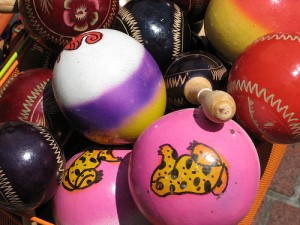 Here’s an idea: collect a bag full of fun world percussion instruments, like claves, maracas, a shekere, agogo bells, finger cymbals, tambourines, or caxixi. You can play this guessing game in teams or choose not to make a competition. If you don’t have access to many instruments, you can add some electronic ones from websites like Virtual Music Instrument which includes a drum set, pan flute, and bongos.
Here’s an idea: collect a bag full of fun world percussion instruments, like claves, maracas, a shekere, agogo bells, finger cymbals, tambourines, or caxixi. You can play this guessing game in teams or choose not to make a competition. If you don’t have access to many instruments, you can add some electronic ones from websites like Virtual Music Instrument which includes a drum set, pan flute, and bongos.
Introduce each instrument to the class by giving a few fun facts about the instrument and letting children play the instrument. When you play the game, let one student choose an instrument from the bag and have another student try to guess the instrument only by sound. Add extra fun by allowing teams to give hints to stumped team members. After the students guess all of the instruments, play some world music and let the students enjoy the instruments.
Group Call and Response
Many cultures around the world incorporate call and response techniques in their vocal music. Your class can train their ears to hear intervals and learn how to sing using call and response rhythms by singing Easy Ear Training’s “Froggy Interval Hop.” The free download is available here.
First sing the “Froggy Interval Hop” in unison with all of the repeats. Then you can divide the class into two choirs. Choir 1 sings the first line, then Choir 2 repeats the first line. Continue the same all the way through the song. On the fifth line, have the students sing in unison again after the repetition.
You can find out more about African historical influences call and response at “The Influence of Africa: Syncopation, Call & Response, and Timbre“.
Latin Rhythm Party
Kids can learn about Latin rhythms in this fun activity. Hand out traditional Latin instruments like claves, agogo bells, maracas, bongos, and congas. Practice each of the rhythms below together.
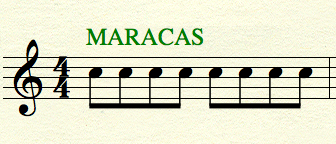
Example 1. Shakers
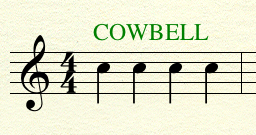
Example 2. Cowbell/Agogo Bell
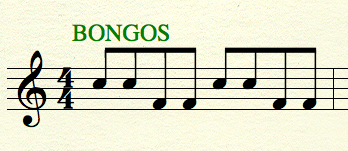
Example. 3 Drums
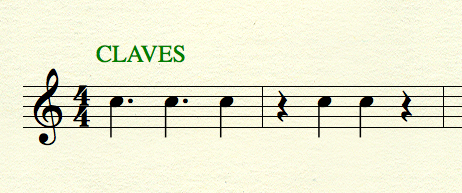
Example 4. Son Clave Rhythm (For Claves or clapping)
Start the dance with the shakers, then add each instrument group. Older children and adults can learn Example 4, the son clave rhythm, the basis for many popular Latin dances including the salsa. Let children “solo” over the group.
Nursery Rhymes from Around the World
Along with lullabies, nursery rhymes can provide another way to introduce your baby or young child to music and rhythm. Check out these fun nursery rhymes from around the world:
- Traditional songs, rhymes, and finger play games in Spanish and English at the Texas State Library Website.
- French Children’s Songs at Mama Lisa’s World.
- Chinese Children’s Songs with audio.
Over to you
Enjoy adding these fun rhythm activities to your life, and discover more easy ear training resources available here at EasyEarTraining.com, like the fun “Monkey Rhythm Dance” and articles on “Singing and Childhood” and “Child Development and Music“.
What other ways have you added rhythm to your life? Share with us in the comments section. We want to hear from you!
Show article sources
Sources
- Ping Ho, Jennie C. I. Tsao, Lian Bloch, and Lonnie K. Zeltzer, “The Impact of Group Drumming on Social-Emotional Behavior in Low-Income Children,” Evidence-Based Complementary and Alternative Medicine, vol. 2011, Article ID 250708, 14 pages, 2011. doi:10.1093/ecam/neq072
- Upitis, R. (2010). Children’s Understanding of Rhythm: The Relationship Between Development and Music Training. Psychomusicology: Music, Mind And Brain, 7(1). Retrieved March 7, 2011, fromhttp://blade2.vre.upei.ca/ojs/index.php/psychomusicology/article/view/416/570
- Stone, N. (2005). Hand-drumming to build community: the story of the Whittier Drum Project. New Directions For Youth Development, (106), 73. Retrieved from EBSCOhost.
- Levinowitz, Ph.D., L. M. (1998). The Importance of Music in Early Childhood. Music Together.com. Retrieved from http://www.musictogether.com/ImportanceOfMusic
- Honig, A. (2006). Learning through Rhythm Rhyme. Scholastic Parent & Child, 14(2), 22. Retrieved from EBSCOhost.
- Shasberger, M. (2009). Better Minds Through Music. Westmont Magazine. Retrieved from http://blogs.westmont.edu/magazine/2009/03/20/better-minds-through-music/

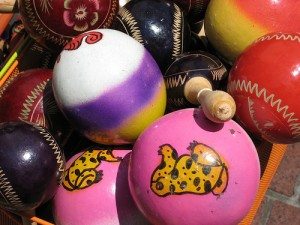







Its like you read my mind! You seem to know a lot about this, like you wrote the book in it or something. I think that you can do with some pics to drive the message home a little bit, but instead of that, this is wonderful blog. An excellent read. I'll certainly be back.